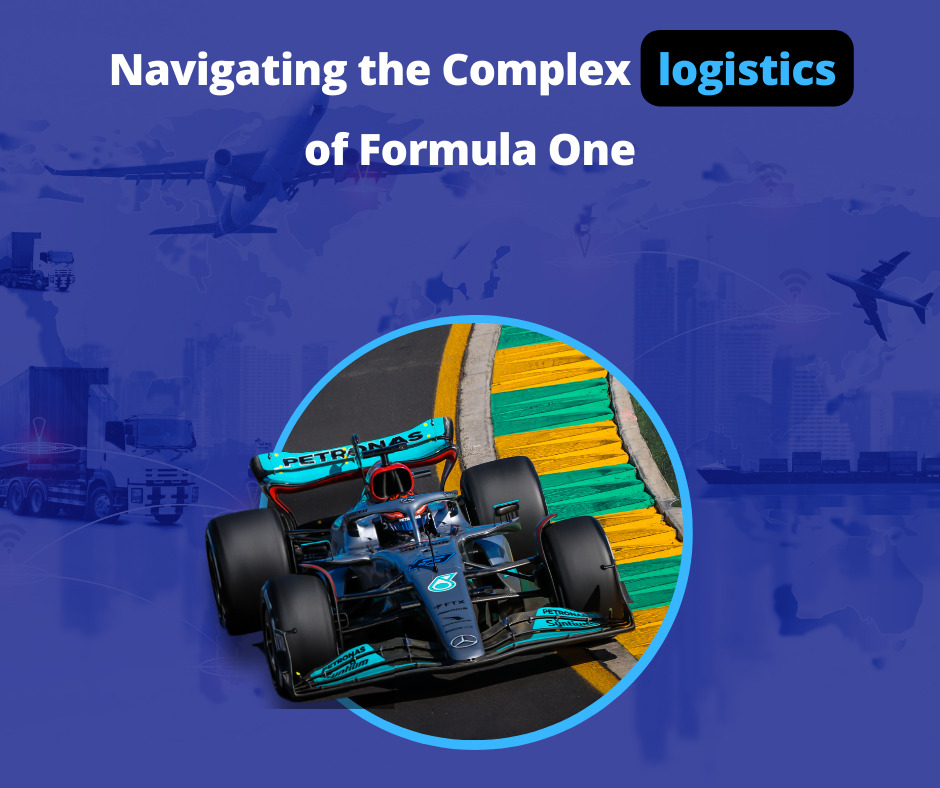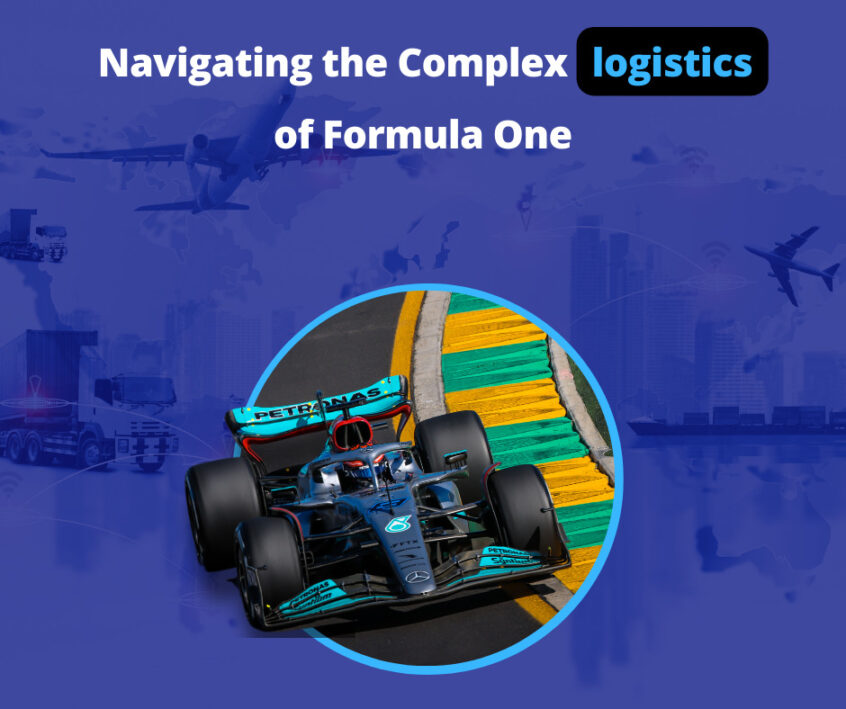
Logistics Ballet of Formula 1 in a Transcontinental Odyssey
The thrilling world of Formula 1 may captivate fans with its speed on the track, but the off-track logistics are equally awe-inspiring. Unveiling the intricacies of moving the entire F1 infrastructure from one corner of the globe to another, particularly the recent 20-hour flight from Las Vegas to Abu Dhabi, reveals a logistical marvel.
With each of the 10 F1 teams investing $100 million, covering 75,000 miles, and transporting a staggering 1,500 tons of equipment, the challenges faced by the F1 logistics teams offer valuable lessons for the broader logistics industry. This article outlines some of the wonders of the logistics in such races.
1. The Herculean Task: Las Vegas to Abu Dhabi
The Formula 1 logistics journey from Las Vegas to Abu Dhabi is a breathtaking aerial odyssey marked by staggering statistics and careful planning.
Flight Span & Time Difference
The sheer distance covered is remarkable. The flight spans 82 miles, an astonishing distance considering the typical race-to-race movement within a country. What adds to the complexity is the marathon duration of 20 hours, turning this journey into a non-stop airborne operation. This endurance challenge is heightened by an 11-hour time difference between Las Vegas and Abu Dhabi, accentuating the need for precise scheduling and adaptation to different time zones.
Strategic Packing Initiatives
The logistics choreography begins during the Vegas race, marking a strategic approach to packing. Non-essential items are promptly identified and packed immediately, reducing post-race downtime. Within 15 minutes after the Vegas race concludes, the comprehensive packing of essential equipment begins. This swift initiation ensures a head start for the logistical team, maximizing efficiency in preparing for the long-haul journey.
Boeing 777s Chartering & Cost Contribution
Loading essential equipment onto Boeing 777s, chartered exclusively for Formula 1, is a crucial phase of this logistical spectacle. Each team contributes to the cost based on the space they utilize in these cargo planes.
The financial commitment of $100 million per team for the entire logistics operation underscores the magnitude of this undertaking. The equitable distribution of costs based on space emphasizes the collaborative nature of F1 logistics, where every team plays a part in ensuring the success of the collective movement.
The Golden Rule: No Touching Until All Arrive
One of the fundamental rules governing this logistical endeavor is the prohibition of any team accessing their equipment until every team’s belongings have arrived in Abu Dhabi. This rule safeguards against any potential advantage gained by teams with early access, ensuring a level playing field. The strict adherence to this golden rule showcases the commitment to fairness and integrity in the fiercely competitive world of Formula 1.
The Race Against the Clock: 48-Hour Paddock Setup
Once on the ground in Abu Dhabi, the race against the clock begins anew. Teams face a tight 48-hour window to set up the paddock, a critical phase involving intricate arrangements of electrical equipment. The precision required in assembling the paddock, which serves as the nerve center for each team during the Grand Prix, underscores the careful planning beyond air travel. Efficient electrical setup is particularly crucial, given the technology-dependent nature of Formula 1, where split-second decisions can make all the difference.
2. Dismantling & Rebuilding Motorhomes: An 18-Month Choreography
In the complex world of Formula 1 logistics, the dismantling and reconstructing motorhomes stand out as a grand puzzle, requiring careful planning and execution.
Global Coordination with DHL
Ten F1 teams, each representing a powerhouse of engineering and technology, coordinate with DHL, the logistics partner of F1, to transport their invaluable cargo: cars, engines, and computers. This collaboration spans different countries and continents, emphasizing the truly global nature of the Formula 1 circus. The logistical intricacies involved in orchestrating the movement of these high-tech components reflect the formidable challenge that logistics professionals face in ensuring the seamless flow of F1’s mobile infrastructure.
Strategic Global Locations & Logistical Challenges
The teams are strategically located worldwide, presenting unique logistical challenges based on their home countries. Teams like Red Bull, Mercedes, Aston Martin, Alpine, Williams, and McLaren call the UK home. Meanwhile, Ferrari, AlphaTauri, and Haas are based in Italy, and Alfa Romeo finds its headquarters in Switzerland. This dispersion adds layers of complexity to the logistics puzzle, as each team’s equipment needs to traverse vast distances, often involving different modes of transportation.
Multimodal Transport: Trucks, Boats & Planes
The transportation of F1’s high-tech cargo is multimodal, incorporating trucks, boats, and planes. This comprehensive approach ensures that the teams’ cars, engines, and computers reach their destination efficiently, regardless of the geographical challenges. At each Grand Prix, a logistical symphony unfolds, with 27 lorries being unloaded over five days. This strategic unloading process, culminating on a Wednesday, sets the stage for the Grand Prix weekend, showcasing the precision required in handling Formula 1’s mobile infrastructure.
Motorhome Assembly & Disassembly
Central to the logistical ballet is the assembly and disassembly of motorhomes, serving as on-site team headquarters during Grand Prix weekends. This is no ordinary task. It involves a substantial crew and takes 32 hours to set up, creating a temporary hub for teams to strategize, analyze data, and fine-tune their race machines. However, the dismantling is a stark contrast, requiring just a day to break down this complex structure. The efficiency in this process is a testament to the precision and planning that goes into every logistical aspect of Formula 1.
In Numbers
Here’s the breakdown. There are:
- 10 Teams: Representing different countries and continents.
- 27 Lorries: Unloaded over five days at each Grand Prix.
- 32 Hours: Required to set up the motorhome, a temporary on-site headquarters.
- 1 Day: Time taken to break down the motorhome, emphasizing efficiency.
3. Back-to-Back European Races: A Race Against Time
In the fast-paced world of Formula 1, the challenge of consecutive races unveils a logistical marathon, demanding clockwork precision and unwavering effort from teams and their logistical crews.
Immediate Post-Race Packing
As the checkered flag falls, the clock starts ticking for the logistical teams. The intense turnaround begins with immediate packing after the race concludes. This involves a strategic process where non-essential items, such as additional engines, are swiftly stored. Meanwhile, the comprehensive packing of essential equipment commences just 15 minutes post-race. This quick initiation sets the tone for the rapid logistical ballet that follows in the race to the next destination.
Clockwork Turnaround
Teams work tirelessly through the night to complete the packing process by 6 am the next day. The urgency in this turnaround is palpable, emphasizing the careful planning and efficient execution required to dismantle the entire operation, pack it up, and prepare for transportation to the following race location.
Drivers in Shifts Covering Vast Distances
A unique aspect of this logistical challenge involves the drivers themselves. Working in shifts, they cover 13 km and 12 hours to reach the subsequent race location, exemplifying the collaborative effort required for the seamless transition between consecutive races. This strategic approach ensures that the entire team arrives in Belgium, for example, by Monday night, ready to embark on the setup for the next Grand Prix.
Rapid Reconstruction Process
Upon arrival at the new race location, the logistical staff engages in a rapid reconstruction process. This includes setting up the entire paddock, involving intricate arrangements of electrical equipment. The crews have a tight 48-hour window to complete this complex task, reflecting the dedication and precision essential for ensuring that everything is ready for the upcoming race.
Marathon Effort
With seven back-to-back races in the 2023 season, transportation crews spend a substantial amount of time on the road—two months per year, to be precise. This staggering statistic highlights the dedication and stamina of the logistical teams. Their ability to maintain the highest standards of precision and efficiency while on the move underscores the immense logistical challenge posed by consecutive races.
The Stats
Here’s the breakdown:
- 15 Minutes: Time taken for comprehensive packing of essential equipment post-race.
- 6 AM: The deadline for completing the packing process is the next day.
- 13 km, 12 hours: Distance covered and time taken by drivers in shifts to reach the next race location.
- 48 Hours: Window for crews to set up the entire paddock upon arrival.
- 2 Months Per Year: Time spent on the road by transportation crews for consecutive races in 2023.
4. The Crucial Role of Shipping Containers: Strategic Cost Savings
Shipping containers play a crucial role in F1 logistics, offering a cost-effective and strategic solution:
- Careful packing of five shipping containers containing non-critical equipment for race weekends before the season.
- Shipping by boat, strategically moving from one flyaway destination to the next, carefully mapping pre-season routes .
- Significant cost savings for each team by leveraging shipping containers instead of airplanes.
- Underscores the importance of strategic choices in global logistics, offering insights for cost-effective solutions in the broader industry.
Wrapping Up
In conclusion, the mind-blowing logistics of Formula 1’s global operations showcase organizational prowess within the sport and provide valuable insights for the broader logistics industry. The seamless coordination, strategic planning, and adherence to strict rules mirror the challenges faced by global supply chains. As F1 teams race worldwide, their logistical triumphs and tribulations reflect the delicate dance that logistics professionals perform daily, navigating challenges and optimizing efficiency in the ever-evolving global transportation and supply chain management landscape.



